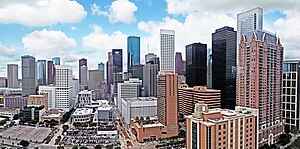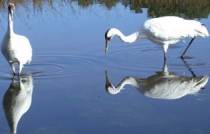Texas Coastal Bend

The Texas Coastal Bend refers to the flat area of land along the Texas coast. It is home to many cities including Brownsville, Corpus Christi, Kingsville, Port Lavaca, Galveston, Victoria, Beaumont, and Houston. The Coastal Bend includes the barrier islands of Texas and the Laguna Madre. According to the United States 2000 Census the Texas Coastal Bend had a population of 6,332,801.
Culture
The Texas Coastal Bend enjoys a rural, urban, and suburban mix of mainly Bi-Cultural, Hispanic and Anglo traditions. African American and Asian/Pacific Islander population and their cultural traditions are well represented throughout this region as well.
Among the universal features which connects the populations of this region, are the ever present summer threats of severe hurricane winds and flooding affecting these predominently flat lands areas. As such, the people of these low topography counties threaded by the Gulf Intracoastal Waterway, are subject to regular evacuations and keep a keen sense hurricane awareness.
The centers of this area are focused around the main population centers in Brownsville, Texas; Corpus Christi, Texas; and Houston, Texas. Much of the rural and suburban areas of the Coastal Bend are predominately White however.
Counties
Most populous cities

| City | 2000 Census Population[1] | County |
| Houston | 1,953,631 | Harris County |
| Corpus Christi | 277,454 | Nueces County |
| Pasadena | 141,674 | Harris County |
| Brownsville | 139,722 | Cameron County |
| Beaumont | 113,866 | Jefferson County |
| McAllen | 106,414 | Hidalgo County |
| Baytown | 66,430 | Harris County |
| Sugar Land | 63,328 | Fort Bend County |
| Victoria | 60,603 | Victoria County |
| Harlingen | 57,564 | Cameron County |
| Edinburg | 48,465 | Hidalgo County |
| Pharr | 46,660 | Hidalgo County |
| Mission | 45,408 | Hidalgo County |
Flora and fauna

The Coastal Bend is a habitat for many types of vegetation[2] and wildlife. Aransas National Wildlife Refuge is among the most prominent centers for wildlife. Wildlife found in the area includes the rare Whooping Crane, American Alligators, Nine-banded Armadillos, West Indian Manatees, and numerous other species of wildlife.
The Texas Coastal Bend is also an area of demarcation between ranges of various vegetative species. For example, the California Fan Palm (Washingtonia filifera) is found only west of the Texas Coastal Bend, or more specifically the Balcones Fault.[3]
Bays

The Bays included in the area:
- Baffin Bay
- Laguna Madre
- Corpus Christi Bay
- Aransas Bay
- Copano Bay
- Matagorda Bay
- San Antonio Bay
- Galveston Bay
- Nueces Bay
- Oso Bay
See also
References
- C. Michael Hogan. 2009. California Fan Palm: Washingtonia filifera, GlobalTwitcher.com, ed. Nicklas Stromberg
- Roy L. Lehman, Ruth O'Brien, Tammy White. 2005. Plants of the Texas Coastal Bend, Texas A&M University Press, 352 pages ISBN 1585444081, 9781585444083
Line notes
- ^ Census Fact Finder
- ^ Roy L. Lehman, Ruth O'Brien, Tammy White. 2005
- ^ C. Michael Hogan. 2009
External links
28°24′N 96°24′W / 28.4°N 96.4°W
